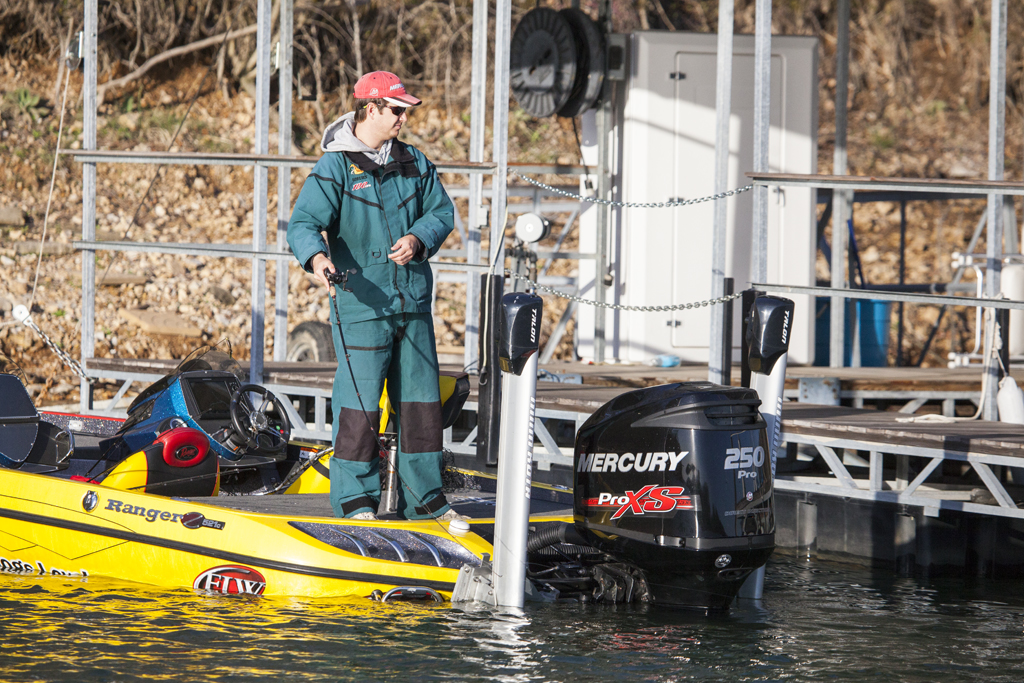My view from the back

Editor’s Note: This is the first in a series of blogs written by Jake Gipson, the two-time FLW College Fishing National Champion who competes now as a co-angler on the Walmart FLW Tour. After graduating from the University of Florida summa cum laude, Gipson accepted a scholarship to the University of Alabama School of Law. He graduated from there this past May, and, because he ranked first in the class, Gipson delivered the valedictory speech at commencement.
Following a fairly successful career as a college angler, I decided to keep progressing up the tournament ladder. The year after graduating from the University of Florida, I fished what was then the Rayovac FLW Series as a professional angler. While I enjoyed some success in my first two tournaments, I quickly realized I had a lot to learn as I got farther away from my home waters. I figured there would be no better way to learn than to get in the boat with some of the best pros in the world as a co-angler on the Walmart FLW Tour. My thought was that getting to see first-hand what makes these guys successful (and sometimes unsuccessful) would help take my fishing to the next level. It’s not an original idea. In fact, a number of the most successful professionals on Tour started their careers as co-anglers. After trying out a few co-angler events last year, I plunged headfirst into the 2014 FLW Tour as a co-angler.
The transition from the front of the boat to the back certainly has its ups and downs. For someone who is used to calling the shots and fishing his own style, competing as a co-angler can be downright frustrating at first. Once past that initial reaction, however, I found that fishing out of the back did help improve my skills and mental game as an angler. My experience at Beaver Lake in 2013 provides a good example.
After a first-day zero, I had a blast catching a tournament-best 16-pound bag with Michael Neal. While that was certainly fun, my true lesson came the next day. As luck would have it, I made the co-angler cut and was paired with Stacey King. Shortly after we met, Stacey informed me that we would be fishing for smallmouths using light line at the dam. To a Florida boy, hearing that was about as foreign to me as hearing we were going to be fishing on Mars. However, after a few adjustments and a little help from Stacey (who is a phenomenal guy) the next day, I was catching fish in a totally new way. To say I learned a ton would be an understatement: 6-pound test and 1/16-ounce jigheads were nowhere to be found in my tackle box before then, but you can bet they are in there now.
In addition to learning some new techniques, fishing as a co-angler has forced me to reevaluate how I approach an area. We all know how we would prefer to fish, but that often isn’t an option as a co-angler. Sometimes, fishing your own way is a hopeless cause. For instance, if you consider yourself to be good at flipping and think you’re going to catch fish flipping behind Randall Tharp when he is flipping, you might want to reconsider your options. Then again, sometimes the pro will simply have the boat positioned so your preferred technique is impossible to apply.
As I’ve encountered situations like that throughout the season, I’ve had to reassess how I fish and discovered that there is usually more than one approach that will put bass in the livewell for you. At times, going to a finesse tactic, such as a shaky head or drop-shot, is the best bet. At other times I’ve found that I can catch fish in a part of the water column that I wouldn’t normally fish. That might mean throwing out the opposite side of the boat to search for untapped structure or keying in on a depth the guy in front simply isn’t fishing. In particular, at Sam Rayburn I narrowly missed the top 20 by keying in on super-shallow fish. While my pros were targeting grass lines, I made sure to hit any good cover in ultra-shallow water. Although I didn’t catch as many, my 4-pound average attested to the quality of the fish I boated.
This year I’ve learned a ton, which hopefully I will get to share with you in future posts. And perhaps the best lesson I have learned is this: Sometimes to get better in the front of the boat, you need to spend some time in the back of the boat. Although fishing the Tour as a co-angler might not be right for everyone, I would encourage anyone to fish from the back of the boat occasionally, even if it’s just fishing with a buddy. Once you get past the initial unfamiliarity with it all, not to mention the limitations it presents, you just might be surprised what you can learn.